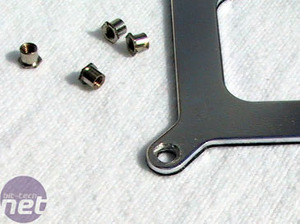The Heatsink:
AOpen provide a heatsink for use with the board, which certainly adds to the overall value of the package, but though installation wasn't without its problems.Where do we start? Firstly, it's proprietary so forget about using anything else unless you have a machine shop and some serious metal working skills (undoubtedly this challenge will be undertaken by someone in our modding community at some point). The product was received after our friends at TrustedReviews had put it through its paces. Thus, the heatsink had already had a few installs.


This is not a promising sign, that after a few more uses the heatsink became all but useless and we were unable to swap it out for anything else. In the end we just had to use another heatsink on top of the CPU with a couple of books on top of that to provide the necessary pressure on the core to maintain a good contact. It’s good enough for us to provide you with performance results but definitely not good enough for the average consumer to use on an everyday basis. If you’re considering buying this product second hand or on eBay, make sure that the heatsink is in good condition before purchasing.
This all comes after AOpen replaced the first heatsink they shipped with early boards because it was too small, now this one is a lot bigger and better but still isn't up to standard.
BIOS and Overclocking:
Initially we were very excited reading about the 400MHz front side bus upper limit for overclocking and voltage controls for CPU, but as it turns out the BIOS we were provided with would crash when adjusting CPU frequency. So we grabbed the latest one off the Internet, which worked until we tried pushing the CPU too far and it suffered a failed boot. That's no big deal as every overclocker knows: a reset of the CMOS later and we were back in business but attempting to overclock again gave us the same BIOS crashing as we had before. We tried to re-flash the BIOS again with absolutely no luck whatsoever.No matter what we tried there was no way it would let us adjust the CPU frequency - so, you've got one shot at overclocking and then that's it. Whilst we had it working, we did manage to hit a tame 600MHz bus speed, over the stock 533MHz but this is far, far shy from the 800MHz+ some people are running with Asus P4C/P4P800 boards and CT479 adapters.
To rub salt into the wound, the upper voltage limit was what our CPU was running 1.35v, so no play there either. Having said that, Pentium M's don't tend to need an awful lot of encouragement when overclocking. There was however, extensive memory timing adjustment for both DDR and DDR2. The Pentium M's with their short pipeline and starved bus bandwidth generally preferring the tightest timings possible over ultra bandwidth because they just don’t use it.
The Smart CPU fan isn’t too smart either. When you reset the CMOS with the latest BIOS you are greeted with it beeping at you until you go into the BIOS and select 'fixed speed' instead, regardless of it you have a fan plugged in or not. But when it does work, it works pretty well until it decides you don't need the fan on at all.
Setting it to spin up to full speed above 60°C and then down below it, it was working great during the short tests but then came our video encoding test; at some point during this test, something went wrong as we came back 15 minutes into it to find a 83°C fully loaded CPU working passively. It is clear that AOpen need to spend some time working on a few aspects, but it seems stable, even under high temperatures and the rest of the BIOS work perfectly fine.

MSI MPG Velox 100R Chassis Review
October 14 2021 | 15:04






Want to comment? Please log in.